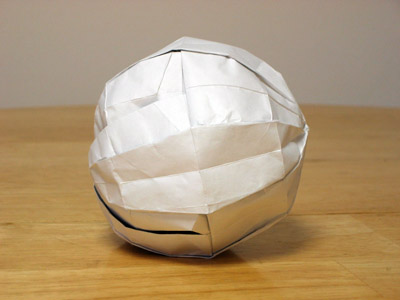Asian Elephant
2008
For thousands of years these graceful, majestic and intelligent creatures have been an important force in human civilization. Elephants make a particularly fun subject for origami. This model uses a variation on my Bear Base for the body, with the sculptural 3-dimensional head.
Diagrammed in: Origami Animal Sculpture . Zing Origami
Baluchitherium
2008
This hornless relative of the rhinoceros lived during the last ice ages. Taller than a giraffe, heavier than a modern elephant, the Baluchitherium may have been the largest mammal ever to walk the earth. Folded from the same size paper as the elephant, the two models will be to scale.
Diagrammed in: Zing Origami
Adirondack Moose
2008
The moose is the largest living member of the deer family, and is easily distinguished by its distinctive antlers. This was a fun and challenging model to design, particularly since my approach focused on simplicity, on the animal's posture, attitude and essential character rather than technical complexity. The design came together quickly as my initial idea turned out to be a good one. The model also has the virtue of standing well on four legs without wanting to tip forward or buckle, since the legs are developed from points in the middle of the paper.
Diagrammed in: Origami Animal Sculpture
The Black Bear (a.k.a. Brown Bear) is a familiar denizen of forests of the Northeastern United States. Campers must be careful to secure their food, or risk providing the bears with a free meal and an unexpected close encounter. This model is the origin of my Bear Base, which is useful for many four-legged animals with a short tail and a detailed head. My bear features a realistic, sculptural body and stylized claws.
Diagrammed in: Origami Animal Sculpture . Zing Origami
Adirondack Canoe
2008
Cutting through the cool smooth waters of a Northern lake, almost silently; the only sound is the slight splash of the oars. Around the next bend you might spot a butterfly, a loon, or even a moose. This canoe features a full three-dimensional, sculptural design, and even has a little bench.
Diagrammed in: Origami Animal Sculpture . Zing Origami
Adirondack Chair
2008
Nothing beats relaxing out on a deck or by the side of a lake, watching the butterflies and lizards glide on by. This model took a fair amount of experimentation with the proportions and with the detail on the backrest.
Diagrammed in: Origami Animal Sculpture . Zing Origami
Common Loon
2008
The Common Loon is a large waterfowl found in the wilderness lakes of Canada and the northeast United States. It is noted for its distinctive black and white plumage. Sighting a Loon is considered a sign of good luck and a healthy lake. Color-change models are always challenging. I had to abstract and simplify the loon's complicated back and white plumage. The stripe on the neck turned out to be the essential feature. To fold the Loon in its winter plumage use paper that is grey on both sides.
Diagrammed in: Origami Animal Sculpture .
Zing Origami
Frog
2008
Developed from my hex base. Unlike the lizard and turtle, the frog is an animal whose back legs are much longer than the front, so the base required some substantial changes. It is fully 3-D and in particular emphasizes the hind legs and the head and brow ridges that fuse into the back.
Diagrammed in: Origami Animal Sculpture
American Turkey
2008
I wanted to created a detailed and realistic turkey. I tackled the subject because I have not seen an origami turkey out there that I like. Mine features a detailed head complete with wattle, a nice round plump body, a fan tail, realistic four-toed feet (better to make it stand), and some nice color change effects. This model features a detailed head with wattle, a tail with a fan of feathers, a sculpted body with wings, and feet with toes on which the turkey can stand and balance. The base is unique and interesting. The main base is something like a semi-sunken stretched bird base, except that it use 15 degree symmetry instead of 22.5. The proportion between the feet and the rest of the body is also based on a 15 degree ratio, which provides some nice symmetries.
Sphere
2008
An approximation of a sphere. I developed 32- and 72-facet versions. It's a nice layout but difficult to fold well. Fun fact: "Sphere" is Thelonious Monk's middle name.
Truncated Octahedron
2008
This fourteen-sided Archimedean solid has six regular hexagons and eight squares as faces. I designed this on a trip to Washington D. C. Folded from a single square sheet.
This fourteen-sided Archimedean solid has six regular hexagons and eight squares as faces. I designed this on a trip to Washington D. C. Folded from a single square sheet.










